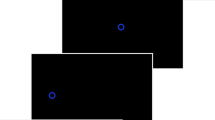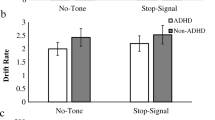Abstract
This study compared inhibitory functioning among ADHD subtype groups on manual and visual versions of the stop task. Seventy-six children, identified as ADHD/I (n = 17), ADHD/C (n = 43), and comparison (n = 20) completed both tasks. Results indicated that both ADHD groups were slower to inhibit responses than the comparison group on both tasks. Comparison children were faster to inhibit than activate responses on both tasks. Children in the ADHD groups also demonstrated this robust pattern on the manual task. However, on the visual task, the ADHD groups evidenced slowed inhibition comparable to the time required to activate responding. This implies that the visual task is more sensitive than the manual task to inhibitory deficits associated with ADHD. The ADHD/I and the ADHD/C groups did not differ on most measures, suggesting that neither stop task is effective in differentiating the subtypes. These findings extend work highlighting the role of disinhibition in ADHD, and contrast recent work suggesting divergence between ADHD subtypes.

Similar content being viewed by others
Notes
The number of participants for each analysis changed slightly due to equipment problems on either the manual or visual task. In Table 3, the number of participants with data for each task within each group is listed.
References
Achenbach, T. M. (1991). Integrative guide to the 1991 CBCL/4-18, YSR, and TRF profiles. Burlington: University of Vermont, Department of Psychology.
Adams, Z. W., Derefinko, K. J., Milich, R., & Fillmore, M. T. (2008). Inhibitory functioning across ADHD subtypes: recent findings, clinical implications, and future directions. Developmental Disabilities Research Reviews, 14, 268–275.
American Psychiatric Association. (1994). Diagnostic and statistical manual of mental disorders (4th ed.). Washington: American Psychiatric Association.
Armstrong, I. T., & Munoz, D. P. (2003). Inhibitory control of eye movements during oculomotor countermanding in adults with attention-deficit hyperactivity disorder. Experimental Brain Research, 152, 444–452.
Barkley, R. A. (1997). Behavioral inhibition, sustained attention, and executive functions: constructing a unifying theory of ADHD. Psychological Bulletin, 121, 65–94.
Berlin, L., Bohlin, G., & Rydell, A. (2003). Relations between inhibition, executive functioning, and ADHD symptoms: a longitudinal study from age 5 to 8 ½ years. Child Neuropsychology, 9, 255–266.
Boucher, L., Palmeri, T. J., Logan, G. D., & Schall, J. D. (2007). Inhibitory control in mind and brain: an interactive race model of countermanding saccades. Psychological Review, 114, 376–397.
Carlson, C. L., & Mann, M. (2002). Sluggish cognitive tempo predicts a different pattern of impairment in the attention deficit hyperactivity disorder, primarily inattentive type. Journal of Clinical Child and Adolescent Psychology, 31, 123–129.
Carr, L. A., Nigg, J. T., & Henderson, J. M. (2006). Attentional versus motor inhibition in adults with attention deficit/hyperactivity disorder. Neuropsychology, 4, 430–441.
Castellanos, F. X., & Tannock, R. (2002). Neuroscience of attention-deficit/hyperactivity disorder: the search for endophenotypes. Nature Reviews: Neuroscience, 3, 617–628.
Castellanos, F. X., Sonuga-Barke, E. J. S., Milham, M. P., & Tannock, R. (2006). Characterizing cognition in ADHD: beyond executive dysfunction. Trends in Cognitive Sciences, 10, 117–123.
Conners, C. K. (1997). Conners’ rating scales—Revised. Toronto: Multi-Health Systems Inc.
Conners, C., Sitarenios, G., Parker, J., & Epstein, J. (1998). The revised Conners’ Parent Rating Scale (CPRS-R): Factor structure, reliability, and criterion validity. Journal of Abnormal Child Psychology, 26(4), 257–268.
Derefinko, K. J., Adams, Z. W., Milich, R., & Fillmore, M. T. (2008). Response style differences in the inattentive and combined subtypes of attention-deficit/hyperactivity disorder. Journal of Abnormal Child Psychology, 36, 745–758.
Diamond, A. (2005). Attention-deficit disorder (attention-deficit/hyperactivity disorder without hyperactivity): a neurobiologically and behaviorally distinct disorder from attention-deficit/hyperactivity disorder (with hyperactivity). Development and Psychopathology, 17, 807–825.
Fillmore, M. T., Milich, R., Lorch, E. P., & Lynam, D. (2008). Inhibitory deficits in children with attention-deficit/hyperactivity disorder: intentional versus automatic mechanisms of attention. Development and Psychopathology, 21, 539–554.
Fillmore, M. T., Milich, R. , & Lorch, E. P. (2009). Inhibitory deficits in children with attention-deficit/hyperactivity disorder: intentional versus automatic mechanisms of attention. Development and Psychopathology, 21, 539–554.
Flory, K., Milich, R., & Lorch, E. P. (2006). Online story comprehension among children with ADHD: which core deficits are involved? Journal of Abnormal Child Psychology, 34, 853–865.
Geurts, H. M., Verte, S., Oosterlaan, J., Roeyers, H., & Sergeant, J. A. (2005). ADHD subtypes: do they differ in their executive functioning profile? Archives of Clinical Neuropsychology, 20, 457–477.
Hanisch, C., Radach, R., Holtkamp, K., Herpertz-Dahlmann, B., & Konrad, K. (2006). Oculomotor inhibition in children with and without attention-deficit hyperactivity disorder (ADHD). Journal of Neural Transmission, 113, 671–684.
Huang-Pollock, C. L., Nigg, J. T., & Halperin, J. M. (2006). Single dissociation findings of ADHD deficits in vigilance but not anterior or posterior attention systems. Neuropsychology, 20, 420-429.
Huang-Pollock, C. L., Mikami, A. Y., Pfiffner, L., & McBurnett, K. (2007). ADHD subtype differences in motivational responsivity but not inhibitory control: evidence from a reward-based variation of the stop signal paradigm. Journal of Clinical Child & Adolescent Psychology, 36, 127–136.
Hudziak, J. J., Copeland, W., Stanger, C., & Wadsworth, M. (2004). Screening for DSM-IV externalizing disorders with the Child Behavior Checklist: a receiver-operating characteristic analysis. Journal of Child Psychology and Psychiatry, 45, 1299–1307.
Klein, C., Wendling, K., Huettner, P., Ruder, H., & Peper, M. (2006). Intra-subject variability in attention-deficit hyperactivity disorder. Biological Psychiatry, 60, 1088–1097.
Lijffijt, M., Kenemans, J. L., Verbaten, M. N., & van Engeland, H. (2005). A meta-analytic review of stopping performance in attention-deficit/hyperactivity disorder: deficient inhibitory motor control? Journal of Abnormal Psychology, 114, 216–222.
Logan, G. D. (1994). On the ability to inhibit thought and action. In D. Dagenbach & T. H. Carr (Eds.), Inhibitory processes in attention, memory, and language (pp. 189–239). Toronto: Academic.
Logan, G. D., & Cowan, W. B. (1984). On the ability to inhibit thought and action: a theory of an act of control. Psychological Review, 91, 295–327.
Logan, G. D., & Irwin, D. E. (2000). Don’t look! Don’t touch! Inhibitory control of eye and hand movements. Psychonomic Bulletin & Review, 7, 107–112.
Lorch, E. P., Sanchez, R. P., van den Broek, P., Milich, R., Murphy, E. L., Lorch, R. F., et al. (1999). The relation of story structure properties to recall of television stories in young children with attention-deficit hyperactivity disorder and nonreferred peers. Journal of Abnormal Child Psychology, 27, 293–309.
Milich, R., Balentine, A. C., & Lynam, D. R. (2001). ADHD combined type and ADHD predominantly inattentive type are distinct and unrelated disorders. Clinical Psychology: Science and Practice, 8, 463–488.
Nichols, S. L., & Waschbusch, D. A. (2004). A review of the validity of laboratory cognitive tasks used to assess symptoms of ADHD. Child Psychiatry and Human Development, 34, 297–315.
Nigg, J. T. (2000). On inhibition/disinhibition in developmental psychopathology: views from cognitive and personality psychology and a working inhibition taxonomy. Psychological Bulletin, 126, 200–246.
Nigg, J. T. (2001). Is ADHD a disinhibitory disorder? Psychological Bulletin, 127, 571–598.
Nigg, J. T. (2005). Neuropsychologic theory and findings in attention-deficit/hyperactivity disorder: the state of the field and salient changes for the coming decade. Biological Psychiatry, 57, 1424–1435.
Nigg, J. (2006). What causes ADHD?: Understanding what goes wrong and why. New York: Guilford.
Oosterlaan, J., Logan, G. D., & Sergeant, J. A. (1998). Response inhibition in AD/HD, CD, comorbid AD/HD+CD, anxious and control children: a meta-analysis of studies with the stop task. Journal of Child Psychology and Psychiatry, 39, 411–425.
Osman, A., Kornblum, S., & Meyer, D. E. (1986). The point of no return in choice reaction time: controlled and ballistic stages of response preparation. Journal of Experimental Psychology: Human Perception and Performance, 12, 243–258.
Pennington, B. F., & Ozonoff, S. (1996). Executive functions and developmental psychopathology. Journal of Child Psychology and Psychiatry, 37, 51–87.
Quay, H. C. (1997). Inhibition and attention deficit hyperactivity disorder. Journal of Abnormal Child Psychology, 25, 7–13.
Schachar, R. J., Tannock, R., & Logan, G. (1993). Inhibitory control, impulsiveness, and attention deficit hyperactivity disorder. Clinical Psychology Review, 13, 721–739.
Schachar, R., Mota, V. L., Logan, G. D., Tannock, R., & Klim, P. (2000). Confirmation of an inhibitory control deficit in attention-deficit/hyperactivity disorder. Journal of Abnormal Child Psychology, 28, 227–235.
Schall, J. D., Hanes, D. P., & Taylor, T. L. (2000). Neural control of behavior: countermanding eye movements. Psychological Research, 63, 299–307.
Weiss, M. D., Worling, D. E., & Wasdell, M. B. (2003). A chart review study of the Inattentive and Combined Types of ADHD. Journal of Attention Disorders, 7, 1–9.
Weller, E. B., Weller, R. A., Rooney, M. T., & Fristad, M. A. (1999). Children’s interview for Psychiatric Syndromes—Parent Version (P-ChIPS). Washington: American Psychiatric Association.
Acknowledgments
This research was supported by the National Institute on Drug Abuse grants DA021027 and DA005312.
Author information
Authors and Affiliations
Corresponding author
Rights and permissions
About this article
Cite this article
Adams, Z.W., Milich, R. & Fillmore, M.T. Examining Manual and Visual Response Inhibition Among ADHD Subtypes. J Abnorm Child Psychol 38, 971–983 (2010). https://doi.org/10.1007/s10802-010-9420-3
Published:
Issue Date:
DOI: https://doi.org/10.1007/s10802-010-9420-3




